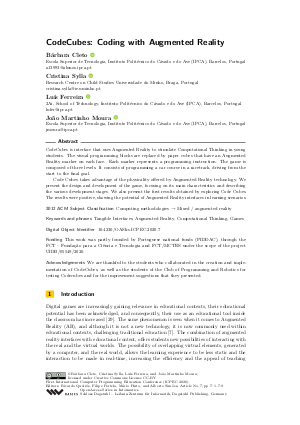OASIcs.ICPEC.2020.7.pdf
- Filesize: 0.57 MB
- 9 pages

 Creative Commons Attribution 3.0 Unported license
Creative Commons Attribution 3.0 Unported license

CodeCubes is interface that uses Augmented Reality to stimulate Computational Thinking in young students. The visual programming blocks are replaced by paper cubes that have an Augmented Reality marker on each face. Each marker represents a programming instruction. The game is composed of three levels. It consists of programming a car course in a racetrack, driving from the start to the final goal. Code Cubes takes advantage of the physicality offered by Augmented Reality technology. We present the design and development of the game, focusing on its main characteristics and describing the various development stages. We also present the first results obtained by exploring Code Cubes. The results were positive, showing the potential of Augmented Reality interfaces in learning scenarios.






Feedback for Dagstuhl Publishing